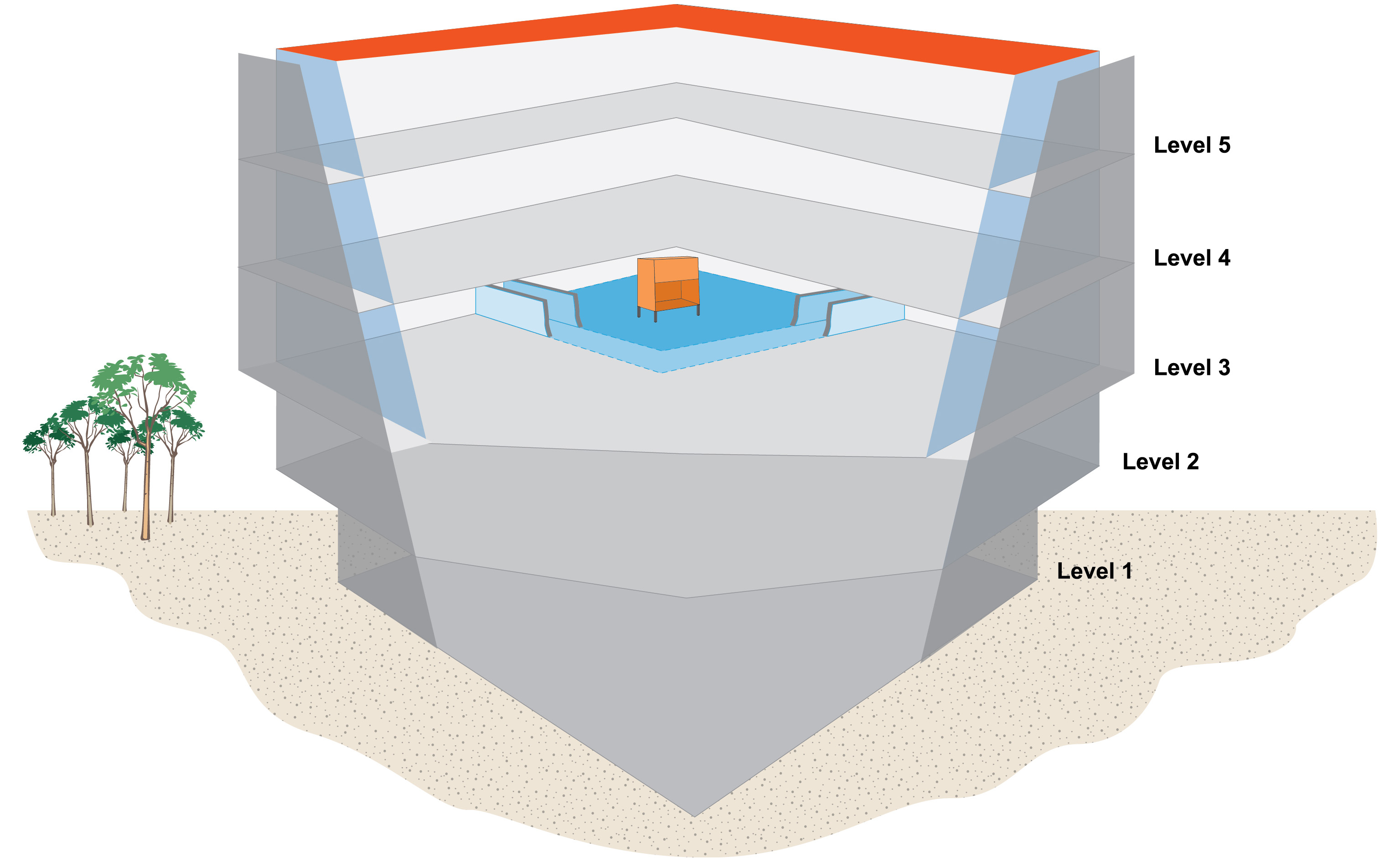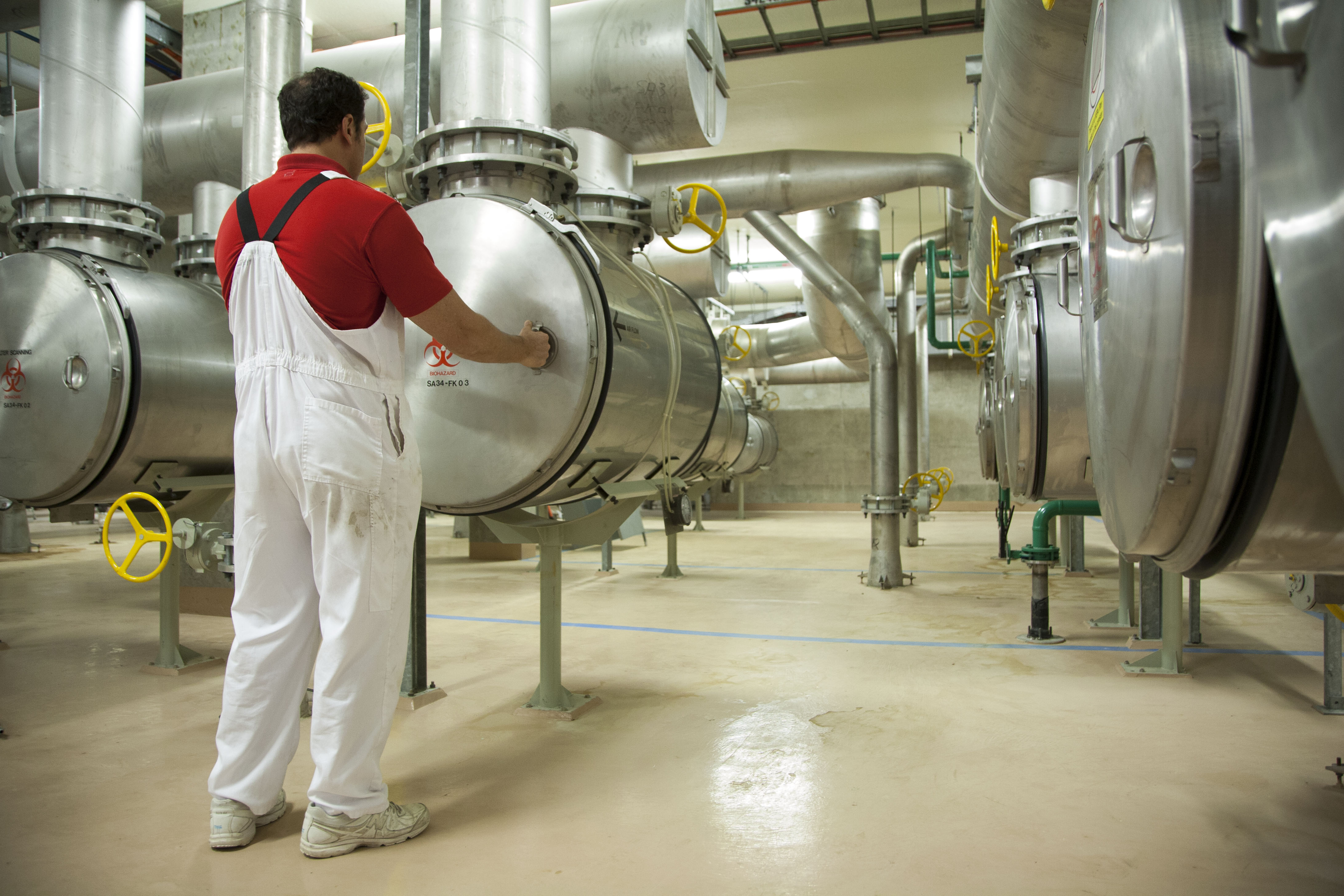A box within a box
 ACDP’s main building has five levels, four of them inside the microbiologically secure barrier. A 30cm thick concrete wall forms an airtight ‘box’ around the secure area.
ACDP’s main building has five levels, four of them inside the microbiologically secure barrier. A 30cm thick concrete wall forms an airtight ‘box’ around the secure area.
All of the secure area is area is held at a lower air pressure than the outside world, to keep any airborne infectious agents inside the laboratory.
Within the secure box are a series of smaller secure boxes, each with a drop in air pressure.
Air pressure is controlled so that air will always flow in toward the highest containment zone thus preventing any leakage out.
Four engineering levels are dedicated to supporting one laboratory floor
The five storey building is designed to prevent the escape of microbiological organisms. ACDP's design is held in high esteem world-wide and is still acknowledged as world class 30 years after it was constructed.
- the laboratory floor, level three, is in the centre of the building
- the two engineering floors above house the equipment that filter and distribute incoming and exhaust air, and supply electrical, gas and water services to the laboratories
- the two engineering floors below the laboratories collect and treat all liquid and solid waste.
Multiple layers of protection
A guiding principle in the design and operation of ACDP’s high-containment facility is that biosecurity containment should never be by a single barrier. If one containment system or barrier fails, then at least one other barrier is in place to protect Australia’s animal and human populations.
Therefore at ACDP, all physical containment systems are duplicated, and all essential systems, such as electricity generators, steam and compressed air plants, are triplicated. Containment would therefore not be at risk from a computer or power failure.
Most things never leave the secure area, but those that do must first be treated:
- the air leaving the building is filtered, twice, to remove infectious aerosols
- sewage is heat-treated and solid waste is incinerated
- all equipment leaving the secure area is sterilised by autoclave or gas decontamination
- information is transmitted electronically as books and papers cannot be removed from inside the secure area
- staff and visitors leaving the secure area must leave behind their laboratory clothes, then shower and exit via a secure airlock. Those wearing glasses must decontaminate them in a chemical solution.
Biological security and monitoring
 ACDP has extensive security and monitoring systems to maintain the microbiological integrity of the Facility.
ACDP has extensive security and monitoring systems to maintain the microbiological integrity of the Facility.
Every mechanical operation at ACDP is monitored via the Supervisory Control and Data Acquisition (SCADA) system, supplemented with a security access system and CCTV to record staff movements.
The SCADA system is one of the largest and most complex systems of its type in Australia and includes:
- more than 215 industrial computers or programmable logic controllers
- connected to 29,000 wired signals
- providing information and 200,000 points on the SCADA screens.
The Central Monitoring Service (CMS) uses these systems to monitor equipment and activity across the site, both inside the building and in the grounds, ensuring the safety of staff and visitors, microbiological security, and optimised plant performance.
The system advises the CMS operator of any changes to plant.
Our systems ensure that any potential risks are identified early and there is an immediate response.
The CMS has operated continuously 24 hours a day, 7 days a week since ACDP opened in 1985.
Maximum biosecurity - Physical Containment level 4
The ACDP facility allows work up to the highest designated biosecurity level: Physical Containment level four (PC4), often also referred to as bio-security levl 4 or BSL4. Agents that need to be held at PC4 are those that are highly transmissible and for which there is no vaccine or effective treatment.
ACDP is the only laboratory in Australia that can safely handle exotic zoonotic diseases agents, ie. virus or bacteria that have arrived in Australia from another country, and which pose a major threat to the nation’s animal industries and human health.
Exotic disease agents are used in the laboratory for:
- researching emergency disease diagnosis and developing test kits
- training veterinarians to recognise diseases they would not normally encounter
- researching the relationship between the pathogen and different animal and human hosts.
Procedures and containment facilities at ACDP conform with or exceed the requirements defined in the Australian/New Zealand Standard, Safety in Laboratories, Part 3; Microbiological safety and containment facilities.
Protecting our staff
Our staff wear highly specialised personal protective clothing when working with:
- cell cultures of a PC4 level pathogen or animals that may be excreting viruses potentially fatal to humans. In these situations staff work in whole-body positive-pressure plastic suits that isolate them from the fatal disease hazard
- viruses such as Newcastle disease which humans can carry in the respiratory tract or the eyes. Staff wear breathing-air hoods to avoid becoming contaminated themselves and risk transmitting the disease.
The biosafety training to work at these levels of physical containment is extensive and ongoing.
The personal containment procedures are backed up by compulsory showering out of infected animal rooms and out of the secure area.
Once outside the secure area, staff must not have contact with livestock animals for seven days.
A box within a box
ACDP’s main building has five levels, four of them inside the microbiologically secure barrier. A 30cm thick concrete wall forms an airtight ‘box’ around the secure area.
All of the secure area is area is held at a lower air pressure than the outside world, to keep any airborne infectious agents inside the laboratory.
Within the secure box are a series of smaller secure boxes, each with a drop in air pressure.
Air pressure is controlled so that air will always flow in toward the highest containment zone thus preventing any leakage out.
Four engineering levels are dedicated to supporting one laboratory floor
The five storey building is designed to prevent the escape of microbiological organisms. ACDP's design is held in high esteem world-wide and is still acknowledged as world class 30 years after it was constructed.
- the laboratory floor, level three, is in the centre of the building
- the two engineering floors above house the equipment that filter and distribute incoming and exhaust air, and supply electrical, gas and water services to the laboratories
- the two engineering floors below the laboratories collect and treat all liquid and solid waste.
Multiple layers of protection
A guiding principle in the design and operation of ACDP’s high-containment facility is that biosecurity containment should never be by a single barrier. If one containment system or barrier fails, then at least one other barrier is in place to protect Australia’s animal and human populations.
Therefore at ACDP, all physical containment systems are duplicated, and all essential systems, such as electricity generators, steam and compressed air plants, are triplicated. Containment would therefore not be at risk from a computer or power failure.
Most things never leave the secure area, but those that do must first be treated:
- the air leaving the building is filtered, twice, to remove infectious aerosols
- sewage is heat-treated and solid waste is incinerated
- all equipment leaving the secure area is sterilised by autoclave or gas decontamination
- information is transmitted electronically as books and papers cannot be removed from inside the secure area
- staff and visitors leaving the secure area must leave behind their laboratory clothes, then shower and exit via a secure airlock. Those wearing glasses must decontaminate them in a chemical solution.
Biological security and monitoring
ACDP has extensive security and monitoring systems to maintain the microbiological integrity of the Facility.
Every mechanical operation at ACDP is monitored via the Supervisory Control and Data Acquisition (SCADA) system, supplemented with a security access system and CCTV to record staff movements.
The SCADA system is one of the largest and most complex systems of its type in Australia and includes:
- more than 215 industrial computers or programmable logic controllers
- connected to 29,000 wired signals
- providing information and 200,000 points on the SCADA screens.
The Central Monitoring Service (CMS) uses these systems to monitor equipment and activity across the site, both inside the building and in the grounds, ensuring the safety of staff and visitors, microbiological security, and optimised plant performance.
The system advises the CMS operator of any changes to plant.
Our systems ensure that any potential risks are identified early and there is an immediate response.
The CMS has operated continuously 24 hours a day, 7 days a week since ACDP opened in 1985.
Maximum biosecurity - Physical Containment level 4
The ACDP facility allows work up to the highest designated biosecurity level: Physical Containment level four (PC4), often also referred to as bio-security levl 4 or BSL4. Agents that need to be held at PC4 are those that are highly transmissible and for which there is no vaccine or effective treatment.
ACDP is the only laboratory in Australia that can safely handle exotic zoonotic diseases agents, ie. virus or bacteria that have arrived in Australia from another country, and which pose a major threat to the nation’s animal industries and human health.
Exotic disease agents are used in the laboratory for:
- researching emergency disease diagnosis and developing test kits
- training veterinarians to recognise diseases they would not normally encounter
- researching the relationship between the pathogen and different animal and human hosts.
Procedures and containment facilities at ACDP conform with or exceed the requirements defined in the Australian/New Zealand Standard, Safety in Laboratories, Part 3; Microbiological safety and containment facilities.
Protecting our staff
Our staff wear highly specialised personal protective clothing when working with:
- cell cultures of a PC4 level pathogen or animals that may be excreting viruses potentially fatal to humans. In these situations staff work in whole-body positive-pressure plastic suits that isolate them from the fatal disease hazard
- viruses such as Newcastle disease which humans can carry in the respiratory tract or the eyes. Staff wear breathing-air hoods to avoid becoming contaminated themselves and risk transmitting the disease.
The biosafety training to work at these levels of physical containment is extensive and ongoing.
The personal containment procedures are backed up by compulsory showering out of infected animal rooms and out of the secure area.
Once outside the secure area, staff must not have contact with livestock animals for seven days.
